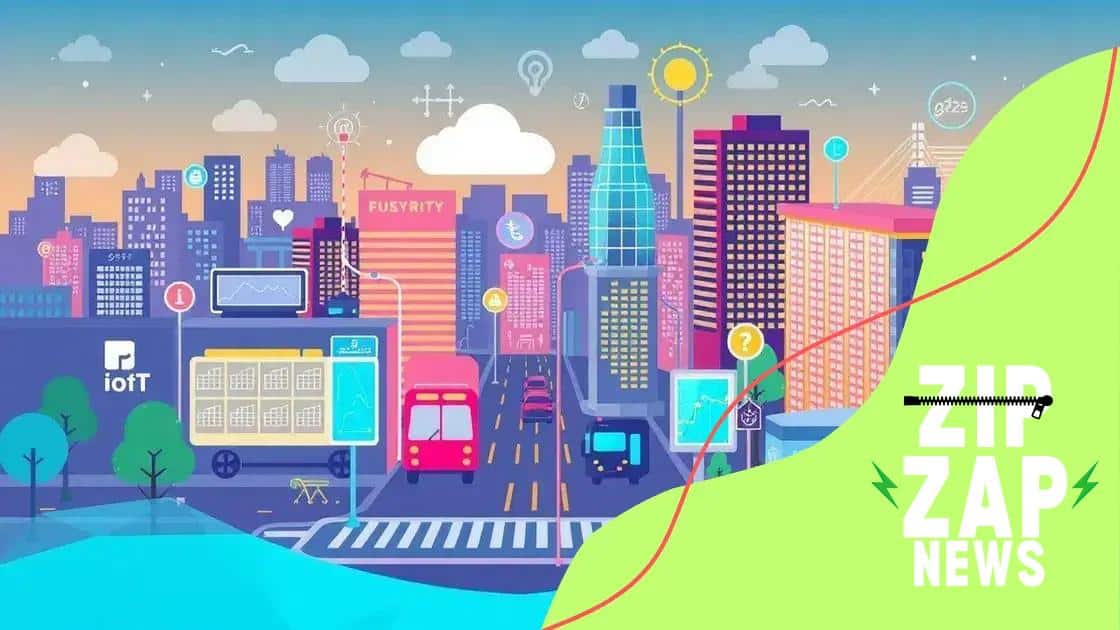Smart cities using AI for urban management

Smart cities using AI for urban management leverage technology to enhance efficiency, improve citizen engagement, optimize resources, and transform everyday urban life through advanced data analytics and intelligent infrastructure.
Smart cities using AI for urban management are transforming our urban landscapes into more efficient and livable spaces. Have you ever imagined living in a city that predicts your needs? In this article, we delve into how AI is shaping the cities of tomorrow.
Understanding smart cities and AI
Understanding smart cities and AI is essential to grasp how technology can improve urban living. A smart city utilizes digital technologies to enhance performance, efficiency, and the quality of life for its residents.
At the heart of smart cities is the integration of artificial intelligence. By processing vast amounts of data, AI can help city officials make informed decisions and provide services that benefit the community.
Key Components of Smart Cities
Smart cities rely on several key components that work together:
- IoT devices: These devices collect data from various sensors deployed throughout the city.
- Data analysis: AI algorithms analyze this data to identify patterns and trends.
- Infrastructure: Smart infrastructure, such as energy-efficient buildings and smart traffic lights, responds to real-time data insights.
- Citizen engagement: Cities interact with residents through apps and platforms, gathering feedback and suggestions.
As cities grow, the need for efficient management becomes critical. By implementing AI, urban planners can tackle challenges like traffic congestion, resource management, and public safety while responding to the unique needs of each community.
How AI Optimizes Urban Management
AI plays a significant role in urban management by enhancing various sectors. For example, in transportation, it can optimize traffic flow and reduce congestion through real-time data analysis. In healthcare, AI helps manage resources to ensure that medical assistance reaches those in need quickly.
The benefits of using AI in smart cities extend to energy management as well. By using predictive analytics, cities can optimize energy consumption and reduce waste. This not only saves money but also supports sustainability initiatives.
The integration of AI into urban management is not without challenges. Issues such as data privacy and cybersecurity must be addressed to ensure the safety and well-being of citizens. However, with careful planning and implementation, smart cities can create a better future for all.
Benefits of AI in urban management
The benefits of AI in urban management are numerous and impactful. Implementing artificial intelligence can significantly enhance the efficiency of city services, leading to a better quality of life for residents.
One of the primary advantages of using AI is improved decision-making. By analyzing data collected from various sources, city officials can make more informed choices about resource allocation and service improvements.
Enhanced Public Safety
Public safety is crucial for every urban area. AI technologies, such as predictive analytics, help law enforcement agencies anticipate and prevent crime. By analyzing historical data, they can identify hotspots and allocate resources where they are needed most.
Additionally, AI can enhance emergency response systems. For instance, real-time data allows responders to react quickly to incidents and optimize their routes, reducing the time it takes to reach those in need.
Efficient Resource Management
Another significant benefit of AI is its ability to optimize resource management. This includes everything from water and energy usage to waste management. For example, with smart meters and sensors, cities can monitor usage patterns and adjust supply accordingly.
- Energy savings: AI can predict energy demand, helping to lower costs and reduce waste.
- Water management: Sensors can detect leaks, minimizing water loss and ensuring supply.
- Waste collection: AI helps optimize collection routes, saving fuel and time.
The integration of AI in urban management leads to sustainable practices. Cities can significantly reduce their carbon footprint by improving efficiency and encouraging residents to use resources wisely.
Overall, the implementation of AI in urban management provides cities with the tools to enhance daily operations and improve the living conditions of their citizens. As smart cities continue to evolve, the role of AI will expand, unlocking further possibilities for innovation and improvement.
Key technologies powering smart cities

Key technologies powering smart cities are transforming urban life by enhancing connectivity and resource management. These technologies not only improve the efficiency of services but also enrich the experiences of residents.
One major technology revolutionizing city management is the Internet of Things (IoT). IoT devices collect data from various sensors and transmit this information for analysis. This setup allows cities to monitor everything from traffic flow to air quality.
Smart Infrastructure
In addition to IoT, smart infrastructure plays a crucial role in developing smart cities. This includes intelligent traffic systems that analyze real-time data and adjust signals accordingly. By doing so, they optimize traffic flow and reduce congestion.
Moreover, smart buildings utilize sensors to control heating, lighting, and energy consumption. This capability leads to lower energy bills and a smaller carbon footprint. With predictive maintenance features, these buildings can identify issues before they escalate.
Data Analytics and AI
Data analytics and AI are essential for interpreting the large volumes of data collected by IoT devices. These technologies enable city officials to identify trends and make data-driven decisions.
- Predictive analytics: Helps forecast public service demands, allowing for better resource allocation.
- Machine learning: Improves city management systems by adapting to changing conditions over time.
- Real-time monitoring: Allows for quick responses to incidents, enhancing public safety.
Additionally, digital platforms enhance citizen engagement, allowing residents to interact with their city governance easily. Apps and websites provide real-time information about services and give citizens a voice in decision-making.
The integration of these technologies results in a more responsive urban environment. With the power of smart technologies, cities become not only smarter but also more liveable, offering improved public services and enhanced sustainability.
Challenges in implementing AI solutions
Implementing AI solutions in urban management presents several challenges that cities must navigate to achieve success. Understanding these obstacles is crucial for leaders aiming to transform their cities into smart cities.
One significant challenge lies in data privacy. As cities gather vast amounts of data from residents to enhance services, ensuring that this information is protected becomes essential. Citizens must trust that their data will not be misused or exposed.
Integration with Existing Systems
Another challenge is integrating new AI technologies with existing systems. Many urban infrastructures are outdated and may not be compatible with modern solutions. Ensuring that these systems work together requires substantial investment and planning.
- Compatibility issues: New AI solutions must function seamlessly with older technologies.
- High costs: Upgrading infrastructure can be expensive and time-consuming.
- Training needs: City employees often require training to effectively use new technologies.
Additionally, the challenge of obtaining funding for AI projects can hinder implementation. City budgets are often tight, making it hard to allocate resources for advanced technologies. Finding public and private partnerships can help alleviate some of these financial pressures.
Public Acceptance
Furthermore, gaining public acceptance for AI initiatives is crucial. Residents may be skeptical about AI’s role in their daily lives, fearing job losses or changes to community dynamics. Educating the public about the benefits of AI and how it can enhance urban living is vital to overcoming this barrier.
Finally, ensuring ethical AI use is paramount. Transparency in how AI systems make decisions and ongoing monitoring of these systems is necessary to maintain public trust. Addressing these challenges head-on will pave the way for successful AI implementation in urban environments.
The future of urban living with AI
The future of urban living with AI promises to be transformative and exciting. As cities evolve, they will increasingly harness the power of artificial intelligence to create environments that prioritize convenience, sustainability, and enhanced quality of life.
One key aspect of this future is the rise of smart homes and buildings. These structures will integrate AI technologies to optimize energy usage, improve security, and enhance comfort. Imagine homes that adjust their heating and cooling based on weather forecasts or automatically lock doors when residents leave.
Smart Transportation
Transportation will also undergo a significant transformation. With AI, cities will be able to manage traffic flows in real-time, reducing congestion and pollution. Autonomous vehicles could become common, providing safe and efficient transportation options. Integrating public transport with AI systems will ensure smoother journeys for commuters, leading to a more connected urban environment.
- Real-time data: AI will analyze traffic patterns to optimize signal timings.
- Public transport efficiency: AI will help reduce wait times and improve route planning.
- Eco-friendly solutions: AI will assist cities in exploring sustainable transportation options like shared mobility.
The implementation of AI will also enhance public services. Governments will use data-driven insights to allocate resources effectively, improving healthcare, education, and emergency services. For instance, predictive analytics will help hospitals anticipate patient needs and allocate staff accordingly.
Civic Engagement
In the future, residents will interact more easily with their local governments through AI-powered platforms. Citizens will voice their opinions, report issues, and access city services via user-friendly applications. This engagement fosters a sense of community and helps ensure that public policies align with the needs of residents.
Ultimately, the landscape of urban living will be shaped by the integration of AI. These innovations will not only streamline operations but also create safer, more sustainable, and enjoyable environments for all residents. Embracing this future will lead to more resilient and intelligent cities.
The future of urban living with AI holds great promise for cities around the globe. By embracing new technologies, urban areas can become smarter, more efficient, and more responsive to the needs of their residents. From optimized transportation to enhanced public safety, AI will transform our daily lives. Moreover, citizen engagement will shape these advancements, ensuring that everyone has a voice in their community’s evolution. As cities continue to innovate, the potential for a better quality of life is within reach, making smart cities a tangible reality for the future.
FAQ – Frequently Asked Questions about AI in Smart Cities
What are smart cities?
Smart cities use technology, like AI, to enhance living conditions, optimize services, and improve resource management.
How does AI improve urban transportation?
AI helps optimize traffic flows, reduce congestion, and enhance public transportation efficiency through real-time data analysis.
What role does citizen engagement play in smart cities?
Citizen engagement ensures that residents have a voice in decision-making, leading to better alignment of city services with community needs.
What are the challenges of implementing AI in cities?
Challenges include data privacy concerns, the need for integration with existing systems, funding limitations, and ensuring public acceptance.





